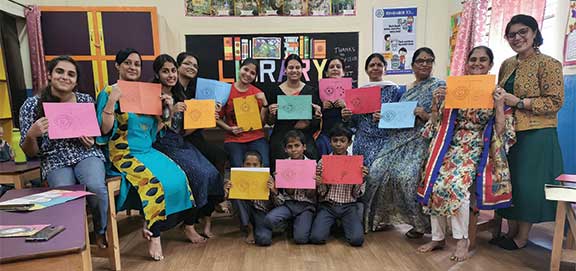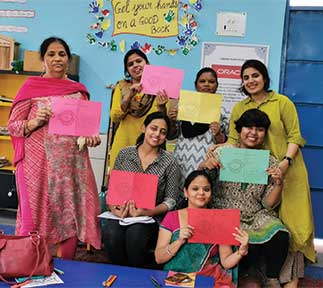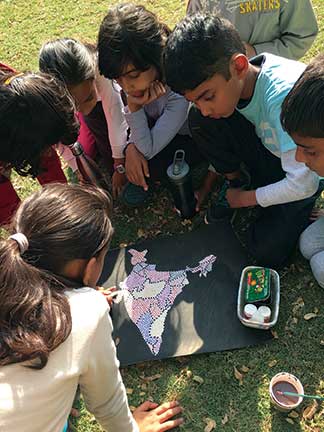Siddhi Gupta
If I could list only two takeaways from school, they would both have to be friends. My closest friends are still my batch mates from school. All of them are currently in different parts of the world but it is still like old times when we meet (which is seldom). My other friends were my teachers. We would solve sudoku together, plan events at school, coordinate trips, usher students back to classrooms, check uniforms and so on. Yes, I was a bit of the teacher’s pet but it was about more than just getting the attention. This bond had a special value for the young me who was unknowingly nurturing a teacher inside her.

I am not an educator or a curriculum developer by training. I am a visual communication designer, passionate and determined to contribute to art and design education. But to realize any part of this I had to get into schools and be in the classroom. I have spent the last six years in various classrooms and learnt everything about the job from the expert – the teacher. Still, today, every time I’m at school, I feel like I’m somewhere in between the student-teacher role. Part student and part teacher, an outsider who has been generously allowed to participate in the ecosystem.
My first formal stint in education was as an arts facilitator at Mirambika in Delhi. As part of this role, I was facilitating art sessions to test if Indian folk art could be introduced in classroom learning in schools. A new teacher, exploring a new subject can be unnerving but Mirambika is magic and I definitely received more from there than I gave. I found friends in people who had been teaching all their lives and we played together, laughed together, ate together, made art together, reflected together. Teachers at Mirambika worked together and not in silos, subjects intermingled and learning was delivered as one holistic package to the learner. Each week in advance, I used to interact and collaborate with the group in-charge for the next week’s session. But it wouldn’t stop at the planning, we would get together to procure material and we would run the session together as well. The in-charge would know the needs of each learner and exactly what would connect my session to the other pieces of learning. Most special was the gung-ho with which the in-charge would participate during the session. I got some really great advice at Mirambika, I learnt to do and show instead of just talk and expect. I learnt that making is best, when it is done together and that learning is a collaborative activity.

Since then, I have collaborated with over 200 teachers across the country to find ways to integrate art in education and take a piece of Mirambika to them. Almost all of these interactions have been with mixed groups of teachers, teaching different subjects and age groups often at different schools. Yet, the teachers would collaborate with each other naturally. It was like they had always known each other. Another reflection was how little efforts were put into facilitating this at their respective institutions.
I have often felt that teachers are not heard enough. In my workshops, sports teachers and economics teachers would make art for the first time and the experience would be similar to my time with very young students who were enjoying themselves with colours and paints. They would share how impressed they were with themselves with such ease and candour, it would make me very connected to their teaching and learning. I made some great friends at the workshops. Friends who offered me their minds, hearts and ears before and after the workshop so that I could get detailed feedback on how it went. They would help me spread the word far and wide and respond first when no other participant in the room would. They were my cheerleaders, supporters and eventually collaborators.

In my current role I am interfacing between seven government schools and a group of designers who are for the first time in their lives teaching in the K-12 context. It is an eclectic mix of people from across the country who I resonate with at different levels. While each of these individuals have found their own ways of mixing within their assigned schools, I find great value in them bringing these experiences to our group meetings. Every evening we come together for half an hour, check in to reflect on our day and together prepare for the next day’s session. These meetings are not mandatory and I have noticed that those who come to a couple of these meetings tend to make the effort to catch them regularly. I have not asked what these meetings mean to them but to me it is a safe space to share my challenges, my wins and get validations on my experiments. Beyond that, I learn from other people’s experiences, imbibe their enthusiasm, win in their win and find a win when they feel that they had absolutely lost it that day.
I look forward to being with this group everyday and sharing my reflections because no one understands my experience more than they do. No one relishes a child’s response to a question I asked, as much as them or listen to my retelling of the full list of excuses I heard that day or most importantly teach me when to tell the student that it is not a ‘me problem’ but a ‘you problem’. I think we can compare this to a typical staff room type situation which is all about support, growth and learning.

Teaching is not a piece of cake, it is an emotionally, physically and mentally draining activity and one needs all the support they can get, especially as an outsider. I am grateful to all the schools and teachers who have welcomed me (and the likes) into their schools, that initial bout of trust and support sometimes is everything. Because when you are welcomed inside the staff room by someone who is already friends with everyone else it is easier to make space for yourself and do what you want to do and eventually make some friends of your own.
I did not plan to work in education, it just happened and I’m grateful for it. Sometimes I wonder if what draws me to work and connect with teachers in the first place are my own experiences as a student. I am not saying here that my experiences were perfect, I often criticize them and must ensure you that they were very typical to any other urban school in India. But what they made clear was that teachers are not given their due. Neither within the school, and definitely not outside of it. I cannot of course change all of this, but knowing this, the least I can do is become their friend, their person. And more selfishly I’m most interested in the teacher piece, because often the impact of connecting and working with even one teacher is enough. You impact all the classrooms and students they will ever touch. A friendship with a teacher only gives. They make an unconditional investment in your learning, in your growth, in your ambition. In short, they are keepers.
The author is a designer, educator and researcher working at the intersection of culture and communication. She is professionally associated with IIT Delhi, JusticeAdda, Femlab.co and Nalandaway Foundation and can be reached at siddhi.gupta@rca.ac.uk.
